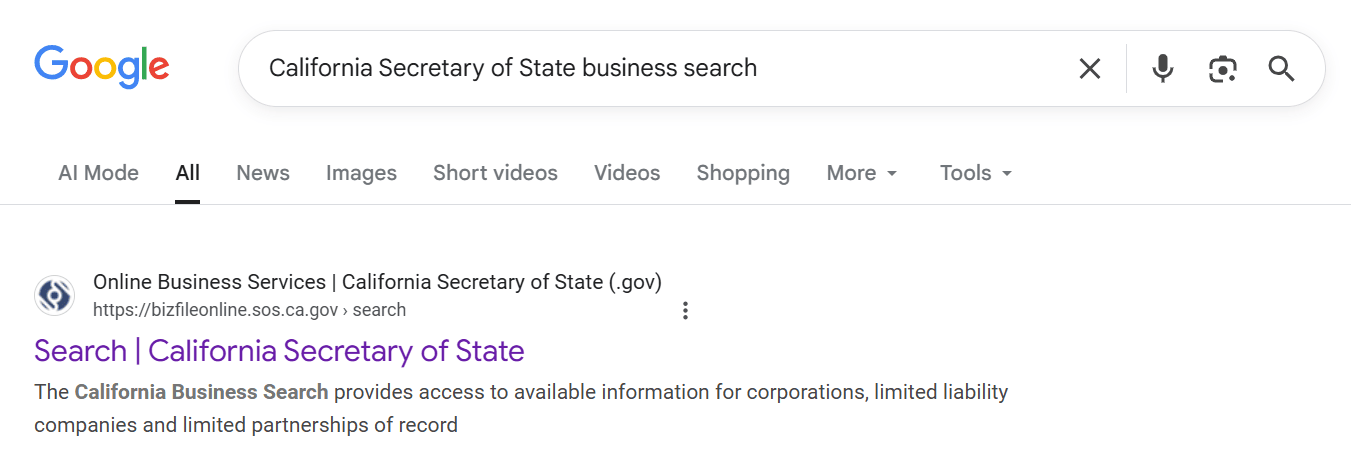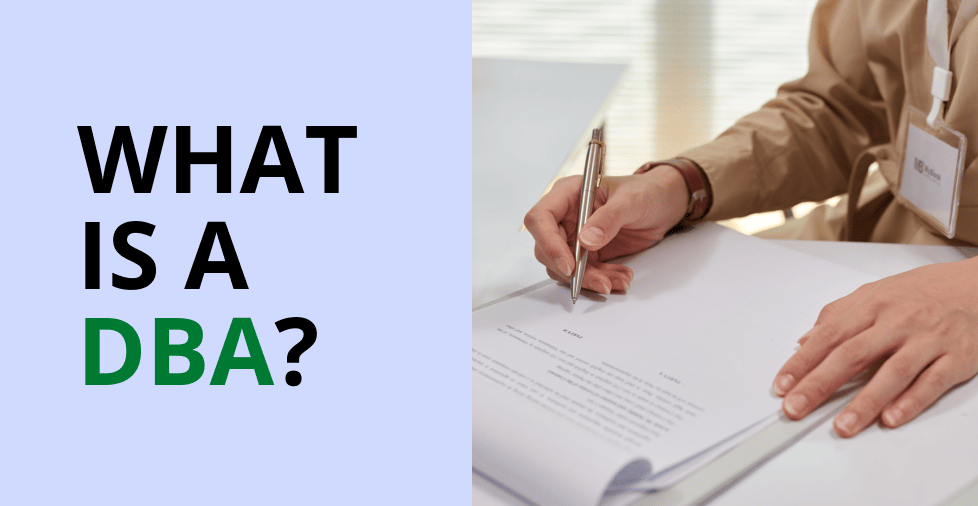Key takeaways:
- A DBA (Doing Business As) is a fictitious business name that allows companies to operate under a name different from their legal entity name for branding and marketing purposes.
- DBAs help enhance professionalism, improve marketing effectiveness, support business diversification, and enable geographic market adaptation without creating separate legal entities.
- Filing a DBA typically costs between $10-$150 and involves checking name availability, submitting forms to state or county clerks, and meeting publication requirements.
“What is a DBA?” Ever since you started your business, you’ve probably been asking this question. Understanding what a DBA offers can unlock significant opportunities for your company.
Find out what a DBA is, when to use it for your business, and how to file it, all in our guide below.
What is a DBA?
A DBA, which stands for “Doing Business As,” is a fictitious business name that lets a company use a name other than its legal name. It’s a nickname for your business that you can leverage for branding, marketing, or expansion without creating a separate business entity.
For example, a sole proprietor like Sloane Wilder might offer consulting services under the legal business name “Sloane Wilder Consulting LLC.” However, to make her business name more marketable, she might register “Growth Strategies Pro” as her DBA name.
DBA vs. trademark vs. LLC
Filing a DBA isn’t similar to getting trademark or liability protection. A DBA doesn’t give you exclusive rights to a name like a trademark does. It also doesn’t offer any legal separation or protection over your personal assets like a Limited Liability Company (LLC) structure does.
When do I need a DBA for my business?
The need to register a DBA depends on a business’ goals and how its owner plans its operations and growth. Here are some scenarios wherein a DBA can support your business effectively:
- When you want to enhance your branding and marketing strategies
- When you want to show professionalism
- When you want to diversify your products and services
- When you want to adapt to geographic markets
When you want to enhance your branding and marketing strategies
Registering a DBA allows you to use a unique name that’s more impactful on customers and sets you apart from competitors. This makes it easy for people to find and recall your brand, while also serving as the foundation for all your marketing materials.
For instance, doesn’t the trade name “Hydro Flask” sound catchier than its official name, “Steel Technology, LLC?”
It’s also distinctive from its competitors, like Stanley and YETI, as it instantly communicates what the business offers. This clarity makes marketing more effective for potential customers.
This branding flexibility is also valuable for general partnerships, where the legal business name often includes all partners’ surnames—names that can be too long and confusing for marketing.
For example, a general partnership legally named “Bailey, Carson & Schneider Accounting Services” can rebrand as “Finright Financial Partners” through a DBA. This way, they create a memorable brand identity that’s much easier to market than a series of partner names.
When you want to show professionalism
A DBA adds a layer of professionalism that can make a business appear more credible to customers, suppliers, and partners.
This is particularly important for sole proprietorship businesses. When you’re operating under your personal name, this can make potential clients question your legitimacy.
A business name like “The Green Thumb Landscaping,” for example, sounds more established and trustworthy than a service provided by the “John Smith Landscaping Company.” This level of professionalism can affect how clients perceive the business’ quality and reliability.
Beyond appearances, a DBA also lets you open a dedicated business bank account under your business name rather than your personal name. While you can technically open a business account without a DBA, you’re limited to using only your personal name as the account holder.
Having a bank account under your business name reinforces your credibility at every interaction your customers have with your company, whether through invoices or payment processing.
When you want to diversify your products and services
As your business grows, you’ll want to get into new markets or offer different types of products or services.
A DBA can help with such transitions because it allows various business structures, like corporations and LLCs, to expand without forming additional legal entities.
Suppose you’re a small business owner selling baked goods and you want to start a catering service on the side. You can file a DBA for your new venture, which lets you market the catering service under a different name while keeping your original brand for the bakery.
Using different DBAs for different services can help a business manage multiple product lines without creating confusion. It also allows each service to have its own unique branding and marketing plan.
This approach is ideal for businesses that serve different types of customers or have distinct offerings that don’t fit under a single name.
When you want to adapt to geographic markets
A DBA can help a business tailor its identity to a new region by using a more localized name to build trust and appeal to a new community.
Let’s say a coffee shop chain called “Coffee Express” is expanding to New York City. The owner can use a DBA like “The Big Apple Coffee Express” or “The Five Boroughs Coffee Express.”
This way, the business maintains its identity despite using a slightly different name, while its DBA resonates with the local customer base.
How to file a DBA
The requirements and forms for a DBA registration differ by location. However, the general step-by-step process follows a common set of actions, such as:
- Step 1. Check your desired DBA name’s availability.
- Step 2. File with the state or county clerk.
- Step 3. Pay the DBA filing fee.
- Step 4. Meet the state’s DBA publication requirements.
- Step 5. Renew your DBA registration as required.
Step 1. Check your desired DBA name’s availability
Before you file, you should check if the name you want to use is already taken. This is an important step to avoid conflicts with other businesses, and to make sure your new brand name is unique.
The best way to do this is to use the official business entity search database provided by your Secretary of State. Try searching for “[your state] Secretary of State business search,” and the top result will usually lead you to the right place.

Most of these websites have a simple search tool that lets you see if your name is available for registration. It’s also a good idea to search for the name at the county level, as some states manage DBAs through individual county clerk offices.
And if you’re planning to build an online presence for your business, check to see if your desired name is available to register as a domain name. Find out if other businesses are using it as their social media handles as well.
If your digital presence is a priority for your company, use an AI domain generator tool to explore DBA name options that come with available domains. It helps you make sure that you’re registering a DBA that you can use for your marketing and brand recognition efforts.

>>Need ideas for a DBA name? Check out this article: How To Name a Product: 5 Steps to Stand Out in 2026.
You’ll learn about different strategies to come up with a good brand name that you can use as a DBA.
Step 2. File with the state or county clerk
The specific government office where you file your DBA will depend on your state’s regulations.
In some states, you file with the Secretary of State, while in others, you file with the county clerk in the county where your business operates. Some states even require you to file at both levels.
Reach out to your Secretary of State’s office and your local county or city clerk’s office to confirm where to file your DBA application.
The process typically involves filling out a form, often called a “Business Certificate” or “Assumed Name Certificate.” This form will ask for information, like:
- Your business’ legal name
- The assumed business name (DBA) you want to use
- Your business address
- Your business entity type
After you fill out the form, you submit it to the appropriate office, either online, by mail, or in person.
Step 3. Pay the DBA filing fee
The filing fee for a DBA is typically between $10 and $150, and the cost can vary from one location to another. For example, some counties in California have different filing fees despite being in the same state.
This is because some counties in that state require a newspaper publication notice, which costs extra. Some also require you to renew your DBA registration for a fee.
Contact your county clerk directly or check your state or county’s official website for accurate prices.
Step 4. Meet the state’s DBA publication requirements
As we’ve mentioned, some states require businesses to publish a notice in a local newspaper after filing a DBA. This requirement is intended to inform the public that you’re operating under a different name.
The notice typically needs to run for a few weeks in a newspaper of general circulation in your county. The costs for a newspaper publication can vary.
Once the publication period is complete, the newspaper will provide you with a proof of publication or an affidavit, which you then submit to the government office where you filed your DBA.
Step 5. Renew your DBA registration as required
A DBA registration is not always permanent. Most jurisdictions require you to renew your DBA after a certain period. The most common renewal period is every five years.
However, this can change depending on your location. Some states require annual renewals, while others have longer periods.
Renewing your DBA is usually simpler and less expensive than the initial filing. To avoid losing your business name, be sure to keep track of your registration’s expiration date. This will prevent other businesses from registering for it.
DBA registration fees by state
The table below shows current DBA filing fees and renewal terms for five of the most populous states (according to a 2024 report by the United States Census Bureau) in the U.S. However, fees may vary by county within each state and are subject to change.
| State | DBA Filing Fee | DBA Renewal Term |
|---|---|---|
| Texas | $25 | 10 years |
| Florida | $50 | 5 years |
| Pennsylvania | $70 | No set term |
| Illinois | $150 | 5 years |
| Ohio | $39 | 5 years |
Enhance your business image. File your DBA today.
Don’t let a complex legal name limit your business potential. A DBA is one of the most affordable and effective ways to enhance your professional image, attract more customers, and position your business for growth.
Take the first step toward building a stronger brand identity by researching your state’s DBA requirements and filing your application today.
Apart from a stronger brand identity, how about an effective online presence? Here at Network Solutions, we help you with your digital marketing needs.
We offer an AI Website Builder that comes with simple tools that help you bring your business online faster. We also provide expert marketing and web design services that can support your business’ growth online.
It’s now or never, start today!
Frequently asked questions
Having a DBA means that a business is operating under a name that’s different from its legal name. It’s a legal registration that simply gives a business an alias.
For example, a sole proprietor that registered their personal name as their business name can use a DBA to present a more professional brand name to the public.
Neither a DBA nor an LLC is better; the right choice depends on a business’ goals and needs. A DBA is a simple and affordable tool for a business to operate under a different name for branding purposes.
An LLC, on the other hand, is a formal legal business structure that separates the owner’s personal assets from business debts and lawsuits. So, a DBA is for branding, while an LLC is for legal protection. Many businesses use both.
As a title, DBA means “Doing Business As.” When used in an official context, such as on a business registration form or a bank account application, it indicates that the business name is a trade name or alias, not the owner’s legal name.




